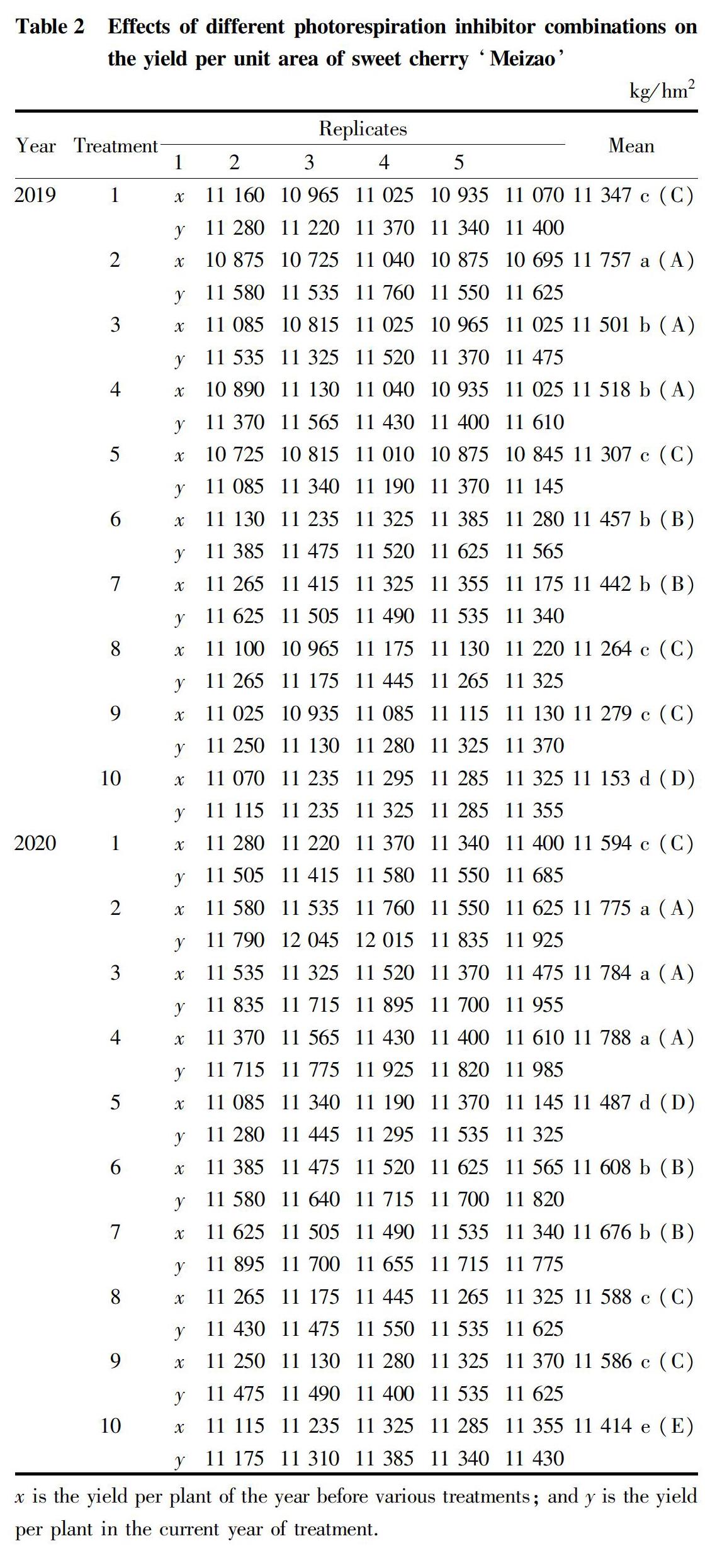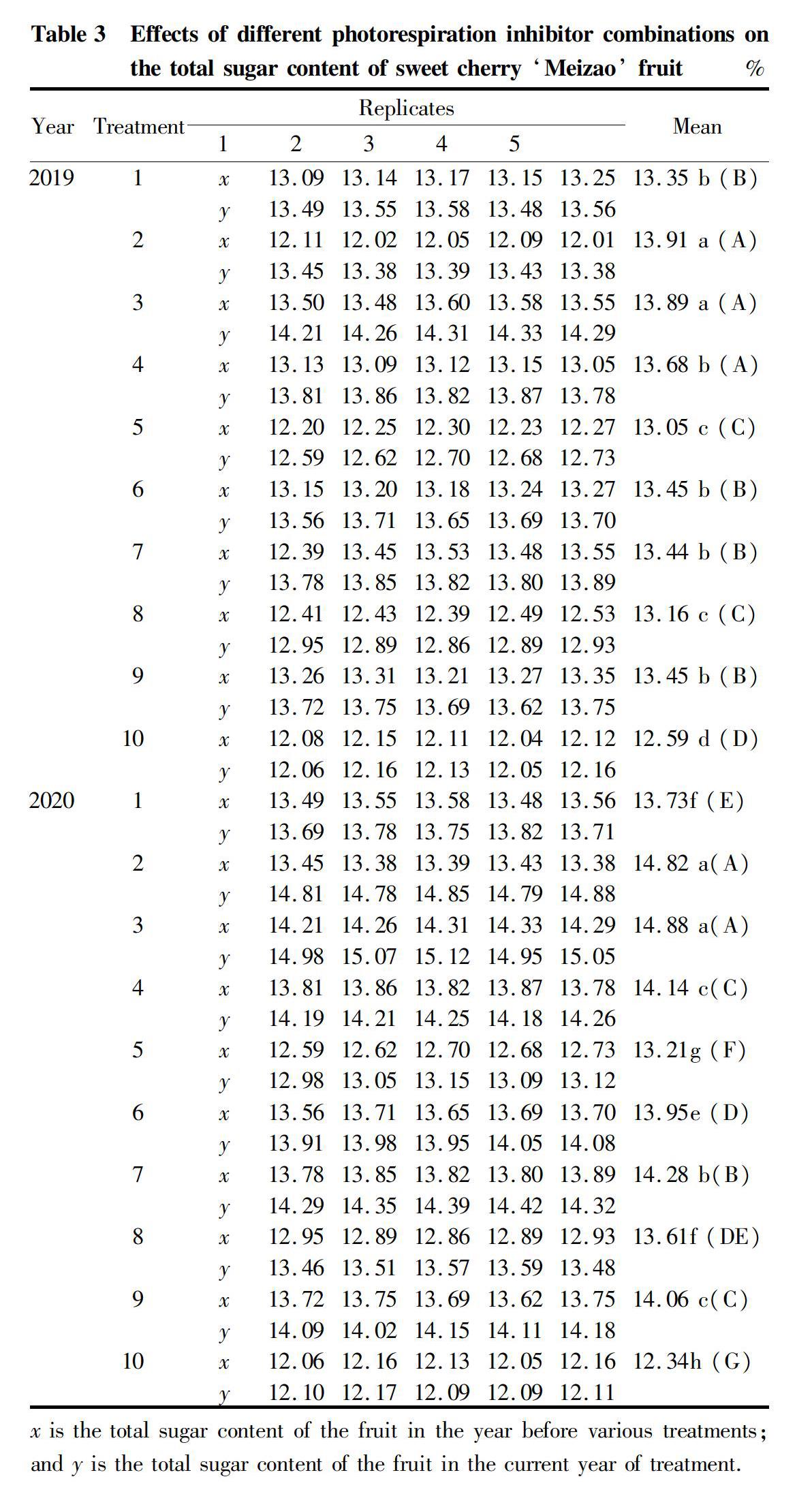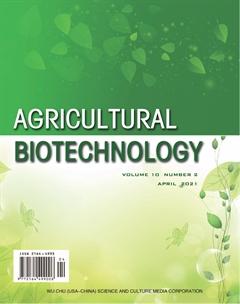Development of a Compound Photorespiration Inhibitor and Its Application on Sweet Cherry
Yilong HOU



Abstract [Objectives] This study was conducted to investigate the effects of compound photorespiration inhibitors on related indexes of sweet cherry.
[Methods]With the main sweet cherry variety ‘Meizao as a test material, relevant research work was carried out.
[Results] Several compound photorespiration inhibitors had a better promotion effect on the photosynthetic capacity, yield and quality of sweet cherry variety ‘Meizao, and especially, the combination of 300 mg/L sodium bicarbonate, 300 mg/L sodium bisulfite, 300 mg/L 2,3-epoxypropionic acid and 1.5% tween-80 had the best effect.
[Conclusions]The combined use of the three photorespiration inhibitors is better than the single use, and produces a good synergistic effect.
Key words Photorespiration; Photorespiration inhibitor; Net photosynthetic rate; Yield; Total sugar content; Leaf thickness
Received: October 23, 2020 Accepted: December 28, 2020
Supported by Dalian Science and Technology Innovation Project (2019J13SN120).
Yilong HOU (1963-), male, P. R. China, professor, PhD, devoted to research about plant biotechnology.
*Corresponding author. E-mail: houyilong@126.com.
The process by which the green cells of plants rely on light to absorb oxygen and release carbon dioxide is called photorespiration. C3 plants such as apple, grape, cherry, wheat and rice have significant photorespiration. Through photorespiration, plants can consume 1/4 to 1/3 of the newly formed organic matter of photosynthesis. The photorespiration of C4 plants such as sorghum, corn, and sugarcane consumes less products of photosynthesis, accounting for about 2%-5% of the newly formed organic matter of photosynthesis. Therefore, photorespiration consumes a large amount of photosynthetic products, especially for C3 plants, which will greatly affect the efficiency of photosynthesis. How to reduce the intensity of photorespiration and reduce the consumption of photosynthetic products has always been a topic of scientific research.
Since the 1970s, researchers at home and abroad have used different photorespiration inhibitors to conduct a large number of research experiments on different crops, and achieved significant results[1-3]. Studies have shown that different crops have different response effects to the same photorespiration inhibitor, and the same crop is affected differently by different photorespiration inhibitors[4]. Single photorespiration inhibitors are often used in production[5]. In order to improve the efficacy of photorespiration inhibitors and overcome the limitations of single photorespiration inhibitors, we organically combined three photorespiration inhibitors, and a spreading agent, which is conducive to the absorption of the drugs, was added, so as to realize the purposes of promoting accumulation of photosynthetic products, improve photosynthetic capacity, and improve crop yield and quality.
Materials and Methods
Experimental materials
The experimental materials were taken from ‘Meizao sweet cherry trees in an orchard in Dalian Economic and Technological Development Zone.
Experimental methods
Reagents
The three photorespiration inhibitors were sodium bicarbonate, sodium bisulfite and 2,3-epoxypropionic acid, and the spreading agent was Tween-80. The concentration range of the three photorespiration inhibitors was 100-500 mg/L, and the concentration range of the spreading agent was 0.5%-1.5%.
Experimental design
The concentration of Tween-80 was designed to be 1.5% (A1), 1.0% (A2) and 0.5% (A3); the concentration of sodium bicarbonate was designed to be 500 (B1), 300 (B2) and 100 mg/L (B3); the concentration of sodium bisulfite was designed to be 500 (C1), 300 (C2) and 100 mg/L (C3); and the concentration of 2,3-glycidic acid was designed to be 500 (D1), 300 (D2) and 100 mg/L (D3). According to the orthogonal design method, 9 experimental treatment combinations were set, namely: treatment 1: A1B1C1D1, treatment 2: A1B2C2D2, treatment 3: A1B3C3D3, treatment 4: A2B1C2D3, treatment 5: A2B2C3D1, treatment 6: A2B3C1D2, treatment 7: A2B1C1D2, treatment 8: A3B2C1D3, and treatment 9: A3B3C2D1, and a control of spraying water (treatment 10) was also set. Each treatment was repeated 5 times. This experiment was aimed to choose the best treatment combination among these treatment combinations. The basic conditions of the experimental trees used in this study were not completely consistent.
Experimental implementation
The per unit area yield and total fruit sugar of cherry ‘Meizao were measured in 2018 and 2019 during the fruit ripening period, and used as the basic information for the covariance analysis of these two indexes in 2019 and 2020, respectively. In 2019 and 2020, the compound photorespiration inhibitor was sprayed to the cherry trees once every 3 d from the flowering period to the fruit ripening period (the net photosynthetic rate and leaf thickness were measured before spraying and used as the basic information for the covariance analysis of these two indexes), 10 times in total. The net photosynthetic rate and leaf thickness were measured 10 d after harvesting, and the per unit area yield and total fruit sugar were measured at the fruit ripening stage. A photosynthetic rate meter was used to determine the net photosynthetic rate in vivo; the anthrone colorimetric method was used to determine the total fruit sugar; and the freehand section method was used to determine the leaf thickness.
Statistical analysis method
Due to the inconsistent basic conditions of the experimental trees used, the test results of the best compound photorespiration inhibitors were statistically analyzed using the covariance analysis in SPSS 20 software.
Results and Analysis
Effects of compound photorespiration inhibitors on the net photosynthetic rate of sweet cherry ‘Meizao
As shown in Table 1, it can be seen that from the experimental results in 2019 and 2020 that the net photosynthetic rates of treatment combinations 2, 3 and 4 were the largest, significantly or extremely significantly higher than the control and other treatment combinations, while the differences between the three were not significant.
Effects of compound photorespiration inhibitors on the yield per unit area of sweet cherry ‘Meizao
As shown in Table 2, it can be seen from the experimental results in 2019 that treatment combination 2 had the highest yield per unit area, which was extremely significantly higher than treatment combinations 1, 5, 6, 7, 8, 9 and the control. It can be seen from the experimental results in 2020 that the per unit area yields of treatment combinations 2, 3, and 4 were the highest, extremely significantly higher than that of the control and other treatment combinations, while the differences between the three were not significant.
Effects of compound photorespiration inhibitors on the total sugar of sweet cherry ‘Meizao
The effects of different treatments on the total sugar content of sweet cherry ‘Meizao fruit are shown in Table 3.
It can be seen from Table 3 that from the experimental results in 2019 and 2020, the total sugar contents in the fruit of treatment combinations 2 and 3 were the largest and had no significant difference therebetween, but were significantly or extremely significantly higher than the control and other treatment combinations, and other treatment combinations were extremely significantly higher than the control.
Effects of compound photorespiration inhibitors on the leaf thickness of sweet cherry ‘Meizao
It can be seen from Table 4 that from the experimental results in 2019 and 2020, it can be seen that the leaf thickness of treatment combination 2 was the largest, significantly or extremely significantly higher than the control and other treatment combinations, and other treatment combinations were extremely significantly higher than the control.
Judging from the two-year research results of the above four indexes, the four indexes comprehensively showed that treatment 2 was most conducive to the accumulation of photosynthetic products, and had the strongest role in improving the photosynthetic capacity, yield and quality of cherry. Therefore, in this study, we determined that treatment 2 was the best compound photorespiration inhibitor.
Conclusions and Discussion
What kind of physiological function does photorespiration has is not yet clear, but the existence of photorespiration does consume a large amount of photosynthetic products, thereby reducing crop yield and quality[6]. This study also confirmed this point through the use of compound photorespiration inhibitors. The results of this study showed that the use of compound photorespiration inhibitors had certain promotion effects on the improvement of cherry yield and quality and the improvement of photosynthetic capacity, and through this study, we also determined the best compound photorespiration inhibitor, which significantly improved the promotion effect. These kinds of photorespiration inhibitors were used in combination, and the spreading agent was added to promote the absorption of photorespiration inhibitors.
Sodium bisulfite, sodium bicarbonate and 2,3-epoxypropionic acid have different mechanisms to inhibit photorespiration. Sodium bisulfite mainly reacts with glyoxylic acid to form α-hydroxy acid salt compounds, reduces the activity of glycolate oxidase, hinders the oxidation of glycolic acid, and inhibits the glycolic acid cycle, thereby inhibiting photorespiration. Sodium bicarbonate mainly promotes the carboxylation activity of ribulose-1,5-bisphosphatecarboxylase and inhibits its oxygenation activity, thereby increasing the ratio of carboxylation to oxygenation and achieving the purpose of inhibiting photorespiration. The chemical structure of 2,3-epoxypropionic acid is similar to glycolic acid, which can inhibit the formation of glycolic acid, and it is a specific competitive inhibitor. Therefore, photorespiration inhibitors can directly or indirectly inhibit photorespiration after being absorbed by the leaves of plants, reduce the consumption of photosynthetic products, make more photosynthetic products accumulate, increase the net photosynthetic rate, promote dry matter accumulation, and increase yield. It is a new way to improve crop yield and quality[7-9]. This study also showed that cherry yield, total fruit sugar, net photosynthetic rate and leaf thickness were significantly or extremely significantly improved, which proved that inhibiting photorespiration can indeed reduce photosynthetic product consumption, increase photosynthetic efficiency, and increase the effective accumulation of photosynthetic products, and improve crop yield and quality.
Studies have reported that although some photorespiration inhibitors such as α-hydroxypyridinemethanesulfonic acid (HPMS), 2,3-epoxypropionic acid (2,3-cOPA), iso-nicotinyl hydrazide (INH), butyl 2-hydroxy-3-butynoate (BHB) inhibit photorespiration, they do not increase the net photosynthetic rate[10-11]. Studies have also pointed out that photorespiration inhibitors can increase the net photosynthetic rate to varying degrees. Wei et al.[4] reported that HPMS, NaHSO3, 2,3-cOPA, and Glu can increase the net photosynthetic rate of rice by 12.0%-15.5%, 8.5%, 8% and 6%-8%. The results of this study showed that the compound photorespiration inhibitors could increase the net photosynthetic rate of cherry ‘Meizao by 1.89%-14.50%. We believe that the fundamental purpose of chemical regulation of photorespiration is to increase the net photosynthetic rate, which is also the key to evaluating whether photorespiration inhibitors have practical value. By improving the net photosynthetic efficiency, the photosynthetic capacity and the accumulation of photosynthetic products are increased, so as to achieve the purpose of improving yield and quality.
References
[1] GUO YP. A study on advances in plant photorespiration[J]. Acta Prataculturae Sinica, 2014, 23(4): 322-329. (in Chinese)
[2] ZHANG ZS, PENG XX. Multifunctional roles of photorespiration and its regulation for the balance[J]. Plant Physiology Communications, 2016, 52 (11): 1692-1702. (in Chinese)
[3] Heilongjiang Agricultural Technology Extension Station. Summary of experiment and demonstration of spraying photorespiration inhibitor sodium bisulfite on soybean[J]. Heilongjiang Agricultural Sciences, 1981(5): 38-40. (in Chinese)
[4] WEI JC, GUO BC, ZHU WX. Study on chemical regulation of photorespiration: Comparison of the effects of several photorespiration inhibitors[J]. Journal of Nanjing Normal Universit: Natural Science Edition, 1981(3): 33-38. (in Chinese)
[5] FU WW, XI YJ, HUANG Z, et al. Effects of photorespiration inhibitosr on citrus fruit quality[J]. Shaanxi Journal of Agricultural Sciences, 2009(4): 86-87. (in Chinese)
[6] PAN RZ. Plant physiology[M]. Beijing: Higher Education Press, 2008. (in Chinese)
[7] YE ZP, WANG YJ, WANG LL, et al. Response of photorespiration of glycine max leaves to light intensity and CO2 concentration [J]. Chinese Journal of Ecology, 2017, 36(9): 2535-2541. (in Chinese)
[8] WANG YF, CHEN ZW, YANG XW, et al. Effects of exogenous melatonin on photosynthetic carbon assimilation and photorespiration in grapevine leaves under O3 stress[J]. Plant Physiology Communications, 2020, 56 (4): 847-855. (in Chinese)
[9] HUANG Z, BAO R, XUE J. Effects of spraying photorespiration inhibitors on citrus fruit quality[J]. Shaanxi Journal of Agricultural Sciences, 2014, 60(10): 9-10, 46. (in Chinese)
[10] KUMARASINGHE KS, KEYS AJ,WHITTINGHAM CP. The flux of carbon through the glycolate pathway during photosynthesis by wheat leaves[J]. J. ExP. Bot, 1977(28): 1163-1168.
[11] SERVAITES JC, OGREN WL. Chemical inhibition of the glycolate pathway in soybean leaf cells[J]. Plant Physiol, 1977(60): 461-466.
- 农业生物技术(英文版)的其它文章
- A Preliminary Screening of Optimum Medium and Symbiotic Fungi for Paphiopedilum dianthum
- Genetic Diversity and Genetic Structure of Maize Inbred Lines from Yunnan Revealed by SNP Chips
- Molecular Marker Techniques Using Single Primers and Their Advances
- The Comparison of Cold tolerance of Three Species of Evergreen Broad-leaved Woody Plants
- Study on Sterilization Method of Endophytic Fungi in Tall Fescue (Festuca arundinacea) and Ryegrass (Lolium perenne) Seeds
- Technical Regulations for Standardized Planting of Rare and Multi-purpose Wild Fruit Kadsura coccinea

